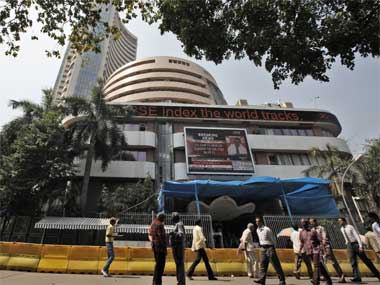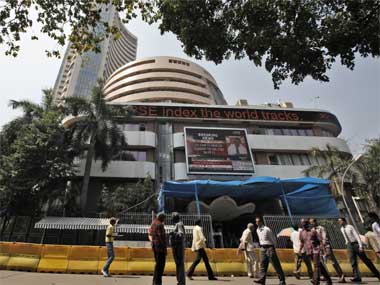The Sensex soared 470.01 points or 1.22 percent at 38,879.49 at 12.15 pm and the Nifty was up 134.40 points at 11,385.40. In the opening session on Thursday, the Sensex jumped nearly 300 points tracking positive cues from global equities as central banks across the globe prepare to combat the economic pressure of the coronavirus outbreak. After surging 299 points in early trade, the 30-share index was up 191.75 points, or 0.50 percent, at 38,601.23, and the NSE Nifty rose 49.25 points, or 0.44 percent, to 11,300.25.
#CNBCTV18Market | Dalal Street sees a green opening with #Sensex up 200 points & #Nifty above 11,300 pic.twitter.com/4kdIuVzalX
— CNBC-TV18 (@CNBCTV18Live) March 5, 2020
HUL, HCL Tech, Tata Steel, Nestle India, TCS and Asian Paints were among the top gainers, while ICICI Bank, L&T, PowerGrid, NTPC and Reliance Industries were trading in the red. In the previous session, the 30-share BSE barometer settled 214.22 points or 0.55 percent lower at 38,409.48, and the Nifty closed 52.30 points or 0.46 per cent down at 11,251. On a net basis, foreign institutional investors (FPIs) sold equities worth Rs 878.38 crore, while domestic institutional investors bought shares worth Rs 764.13 crore on Wednesday, data available with stock exchanges showed, PTI said. [caption id=“attachment_4748931” align=“alignleft” width=“380”]  Representational image. Reuters.[/caption] According to traders, investors were hopeful that the collective efforts of global governments and central banks would cushion the economic fallout of coronavirus. The IMF on Wednesday said will make available about USD 50 billion through its rapid-disbursing emergency financing facilities for low income and emerging market countries that could potentially seek support on account of coronavirus. Bourses in Shanghai, Hong Kong, Seoul and Tokyo rallied up to 1 percent. Stock exchanges in the US too ended sharply higher on Wednesday. Global oil benchmark Brent crude futures jumped 1.37 percent to $51.83 per barrel. Rupee freefall continues The Indian rupee continued its downward journey on Thursday, sliding another 5 paise to trade at 73.44 against the US dollar amid mounting fears of a coronavirus-led economic slowdown.
#Rupee opens lower Vs yesterday's close pic.twitter.com/s7aFCFOxjL
— CNBC-TV18 (@CNBCTV18Live) March 5, 2020
At the interbank foreign exchange, the local unit started the session on positive note but soon nervousness surrounding coronavirus gripped the forex market sentiment, pulling the rupee down to 73.44 against the previous day’s close of 73.39 a dollar. Further weakening sentiment, foreign investors offloaded securities worth Rs 878.38 crore on Wednesday. The dollar index, which gauges the greenback’s strength against a basket of six currencies, was marginally down at 97.33. Global crude oil benchmark Brent was trading 1.33 percent up at $51.81 per barrel. “The panic of corona plays into our domestic market as well as the global front which has forced the funds’ outflows,” said Jateen Trivedi, Senior Research Analyst (Commodity & Currency) at LKP Securities. According to a UN report, the trade impact of the coronavirus epidemic for India is estimated to be about $348 million and the country figures among the top 15 economies most affected as the slowdown of manufacturing in China disrupts world trade. Asian shares grind higher, virus risks block the way Asian shares rallied for a fourth straight session on Thursday as U.S. markets swung sharply higher and another dose of central bank stimulus offered some salve for the global economic outlook. Wall Street seemed to find relief in the strong performance of former Vice President Biden in the Democratic nomination campaign. Biden is considered less likely to raise taxes and impose new regulations than rival Bernie Sanders, Reuters said.
Emerging Markets commentator Geoffrey Dennis and Ramesh Damani #OnCNBCTV18 say that the US market rally has more to do with #JoeBiden's emergence as the frontrunner pic.twitter.com/QRbf3LfQmC
— CNBC-TV18 (@CNBCTV18Live) March 5, 2020
The US House of Representatives also approved an $8.3 billion funding bill to combat the spread of the virus, sending the emergency legislation to the Senate. In another wild swing, the Dow surged 4.53 percent, while the S&P 500 gained 4.22 percent and the Nasdaq 3.85 percent. Asian markets followed, if more cautiously. MSCI’s broadest index of Asia-Pacific shares outside Japan added 0.7 percent, in its fourth day of gains. Japan’s Nikkei rose 0.9 percent and hard-hit Australian shares finally managed a bounce of 1.1 percent. Shanghai blue chips put on 1.3 percent. E-Mini futures for the S&P 500 dipped 0.6 percent after its overnight jump, but EUROSTOXXX 50 futures rose 0.6 percent and FTSE futures 0.4 percent. The upbeat sentiment comes despite the coronavirus crisis showing no signs of slowing, with mounting deaths globally, Italy closing all of its schools and California declaring a state of emergency as cases there grow. “There is little doubt that the COVID-19 outbreak will slow global growth considerably this quarter, and we expect it to actually produce a rare non-recessionary contraction in GDP,” said JPMorgan economist Joseph Lupton. He noted the bank’s all-industry PMI measure of activity for February slumped 6.1 points, the largest one-month drop on record, and at 46.1 was at the lowest since May 2009. The Federal Reserve and Bank of Canada had both responded by cutting interest rates by 50 basis points, and markets in the eurozone are pricing in a 90 percent chance that the ECB will cut its deposit rate, now minus 0.50 percent, by 10 basis points next week. Yet, as policymakers grapple with the best strategy to avoid a global recession, some major central bank have been less keen to follow suit. In the end, monetary policy was not a cure for the disease and the impact was likely to get worse before it got better. “As we test more folks for COVID-19 in the United States, the caseloads will rise and perhaps exponentially. So in the short-term, risk assets obviously remain beholden to Covid-19 headlines,” Tom Porcelli, chief US economist at RBC Capital Markets. “We have to get past the threshold where COVID-19 shifts from panic to headline exhaustion and subsequent news on it becomes more and more of a fade,” he added. “Then risk assets can move higher in earnest.” Healthy, for now At least the US economy was in healthy shape to face the risks, with services sector activity jumping to a one-year high in February, while private payrolls gained 183,000. The better data combined with the rally in stocks to nudge 10-year Treasury yields up from all-time lows under 1 percent to stand at 1.02 percent. Yields had fallen for 10 straight days, the longest slide in at least a generation. That move gave the dollar a slight lift, with the euro dipping back to $1.1140 from a two-month high of $1.1212 hit earlier in the week. The dollar stood at 107.34 yen, from a five-month trough of 106.84, while the dollar index held steady at 97.333. Gold steadied after jumping in the wake of the Fed’s rate cut, and was last at $1,638.97 per ounce. Oil prices rebounded by more than 1 percent on a smaller-than-expected rise in crude oil inventories in the United States. Brent crude futures firmed 68 cents to $51.81 a barrel, while US crude added 59 cents to $47.37. -–With inputs from agencies


)

)
)
)
)
)
)
)
)



